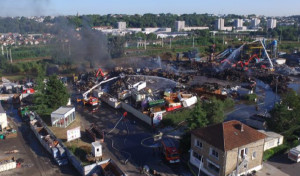At around 9:50 a.m., an employee at a metal and end-of-life vehicle (ELV) salvage company noticed wisps of smoke coming from a 10 m heap of light scrap metal mixed with other waste that was to be shredded. While waiting for the firefighters, the employees attacked the fire with hose reels and fire hoses. The site’s power was shut off. The 30 employees were evacuated. The fire spread to three piles of depolluted ELVs (300 t per pile) located next to the heap of scrap metal. Given the fire’s scale (7000 m²), the firefighters decided to let it burn itself out. In the meantime, they protected the shredder and prevented the flames from spreading. They removed 50 acetylene cylinders from the site. The more than 100 firefighters at the scene hooked hoses to three hydrants and pumped water from the River Seine.
A large plume of smoke rose into the sky and wise visible throughout the Ile-de-France region. A search was made within a 500 m radius to look for people inconvenienced by the smoke. Traffic on the nearby roads and railway lines was halted. Despite the booms placed on the Seine, some pollution from firewater runoff was found (a drone was used to assess the extent of the pollution). Drinking water production plants stopped drawing water from the river. The firefighters and the municipality posted news about the event on social media. The reactions from the public were many.
The fire was contained at 3:45 p.m. and brought under control at 5:20 p.m. Extinguishing operations continued and the operator’s own heavy machinery was used to remove debris. An emergency order requiring the air quality around the site to be monitored until the smoke from the fire had dissipated was issued.
The fire, which was declared out at midday on 7 August, burnt 50 t of scrap metal, 10 t of plastic tanks and 1000 t of depolluted ELVs. In all, 97 vehicles and 227 firefighters (120 at the height of the fire) were required. Extinguishing the fire was made all the more difficult by the heat wave, which helped the fire to grow (fumes released by plastics and hydrocarbons, heated metals, etc.). One employee and four firefighters were slightly injured. The firewater was pumped up and analysed. Environmental monitoring was carried out after the accident (modelling of atmospheric fallout, sampling and analysis of soil, plants and water).
For the operator, the fire could have been started by any of the following causes:
- a prohibited material that went undetected;
- self-heating due to the heat wave;
- a spark during handling;
- a malicious act;
- a cigarette butt.
Corrective measures were taken:
- checks at reception, during sorting prior to crushing and during crushing were tightened;
- waste suppliers received a letter reminding them of what materials are prohibited;
- the awareness of the site’s workers was increased and they were reminded of the operating and emergency procedures;
- the frequency of spraying was increased and an automatic continuous spray system is used during periods of extreme heat;
- the frequency of daily and nightly temperature checks using a thermal imaging camera was stepped up;
- a fire-hose reel and two extinguishers were added;
- workers were reminded that smoking is prohibited;
- the piles of waste were separated by firewalls;
- drills with firefighters;
- material is now removed at a faster rate.




